Kirsten Anderberg's URBAN ADVENTURES:
Big Pines Ski Club History
My family was part of the Big Pines Ski Club in the 1960's - 1970's. The ski lodge still stands on U.S. Forest Dept. land in
the Angeles National Forest. This area is located in
the Swarthout Valley and is the
highest point of the San Andreas Fault. (The bottom of
the San Andreas Fault, by the way, is where we had another summer home, in San Felipe, Mexico.) Wrightwood and Big Pines are in the San Gabriel Mountains, and Wrightwood, the city,
straddles both Los Angeles and San Bernardino Counties. This webpage follows some of the history of Big Pines, CA, and the Big Pines Ski
Club & Lodge. Big Pines is located just outside of Wrightwood, CA, and is about a 2 hour drive from anywhere in the Los Angeles vicinity. The Big Pines Ski Lodge in the 60's-70's
had bedrooms with bunkbeds and a woman's bathroom upstairs, and downstairs (on the right in the picture above) is the
window of the large dining/living room with the big stone fireplace. The enclosed porch was used to take ski boots on and off. The path around the right led to the back annex. You
could walk down into the ravine on the right of this picture and find all sorts of animals gathered around a little stream that ran through the bottom in summer.
The front
of the lodge had a covered area with benches, where skis, poles, boots, etc. were left to dry out (the front windows you see here). It was a sort of false front to the doors of the lodge.
You can see the door at the left of the windowed porch area, that led into the lodge. The windows on the left of the building in the picture are of the kitchen in the front, and the
men's bathroom to the back. There is little written on the internet about the Big Pines Ski Club, but it was quite
a social ski club in its heyday. The Big Pines Ski Club is located in at about 6,000 feet altitude. The driveway to the ski lodge
is located on the left hand side, half way up the road to Table Mountain. There is camping at Table Mountain, and Table Mountain has
an illustrious history interwoven with NASA and the Smithsonian Institute.
I think it is a shame the old ski lodge is falling apart as a private residence, and is not under the care of the community to keep it up and use it freely as a community asset. It is a
beautiful building, in a beautiful place, and I feel it should be treated as the historic monument it is. I feel a community effort to restore and upkeep the old ski lodge is overdue. The
land is still under special use permit for community use. I do not know enough about the history of the Big Pines Ski Club and would love to see your pictures and read your stories of the
ski lodge! You can email them to me at kirstenaATresistDOTca.
According to the book,
"Wrightwood and Big Pines," the Big Pines Ski Club was formed on January 2, 1932. Harlow "Buzz" Dormer was one of the founding members (and built the first rope tow on Table Mountain in 1937). It is reported that at one time, the Big Pines Ski Club was one of
the most active skiing organizations on the West Coast. Its purpose was to create interest in outdoor/snow sports in the Southern CA area. The history of the area as a skiing draw, began in the end of the 1920's to early 1930's, when the area was opened for skiing and recreation, in hopes of
hosting the 1932 Winter Olympics in Wrightwood and Big Pines. There was a large ski jumping hill in the area, which brought the American elite ski jumpers. The book says the
three ski areas that members of the Big Pines Ski Club frequented most often were Blue Ridge, which came about around 1940, and later Holiday Hill followed in 1948, and Table Mountain. Big Pines
Ski Club was at one time the oldest ski club in Southern CA. On page 110 of the book, there is a wonderful picture of three men in ski attire from the early 1900's wearing matching
sweatshirts that say "Big Pines Ski Club."
< The upstairs dorm of the ski lodge consisted of a bunch of metal bunk beds, and one double bed in the middle of the room.
The bunks all had thin mattresses and we rolled our sleeping bags out on them when we came. As you can see by the back of the picture, there was not much decoration going on. The
room was very basic, but we loved sleeping in there as kids. I especially remember sleeping on the upper bunks and looking at the icicles on the roof, hanging in front of the window
at night, up so high, as I would go to sleep. There were 2 other small rooms with a few beds in them, next to the dorm room, that smaller families and
couples sometimes slept in. There was also a women's bathroom upstairs, with a vanity mirror, a dressing room, a shower, and a small room with a toilet. The men's bathroom was downstairs and
had several stalls, unlike the women's room which only had one toilet. Along the stairway upstairs, were lockers built into the wooden walls. We kept things in our locker and then when we came to the ski
lodge, we had certain things there every time, such as cards, etc.
Whenever we came to the ski lodge, my dad would have to go turn on the water down by Jackson Lake. This was how he could tell if anyone was at the ski lodge already and he preferred
to have the ski lodge to ourselves. I remember him cheering or complaining based on whether or not the water was turned on, meaning people were or weren't there already. Most often
when we went to the ski lodge, no one else was there and we had full reign of the place.
In the 1960's and 70's, behind the ski lodge were large iron cages that used to hold bears. I am not sure what the
exact story is with the bear cages, but as children, we used to play in them. There was a rumor bears died in the cages during a forest fire and some of the bars were twisted as if they
melted in fire. It is very hot at the ski lodge location in the summer and wildfires are always a threat. Fire departments were some of the first infrastructure to appear in the area
due to this. I am sure more than a few wildfires have ripped through this area in the last few decades and due to that, I am amazed the ski lodge is still standing.
When I got older (age 8) and was allowed to wander, I found a large abandoned *zoo* up a little path behind the ski lodge.
Apparently there had been an animal park there at one point, which was purportedly how the lodge itself came to be, as a lodge for people to rest in when they came to see the zoo.
The park remnants that I used to play among as a kid, looked like it used to house several different types of animals. The complex was basically a bunch of concrete tunnels and display ledges, with strange doors, etc. As kids,
we played the animals and the zoo keepers...But there is some odd history up there around this zoo. I was told as a kid that the zoo and all its animals burned in a
wildfire, and thus there never was a zoo there again.
In the book, "Wrightwood and
Big Pines," by Pat Krig and Barbara Van Houten, they talk of "the animal park" and say it was begun in the 1920's and was active into the mid-1930's. The animal park
supposedly had buffalo, elk, deer, bears, reindeer and smaller animals, including rabbits. Their book says the animals were moved to other zoos when the park closed. But it did seem like there
was evidence of a fire up in the zoo areas where we used to play in the 1960's, so I am not sure about the complete history of this. I remember the bars of the bear cage right behind the lodge
also seemed melted and burned. They were all twisted and broken in places.
Maybe the fires that damaged the zoo and melted its bars
came after the animal park had closed. Or maybe the bars were cut off for some other reason and as a kid, it seemed like they were melted. I need to go back up there
and inspect them to see if they look melted the way I remember them. I have heard since that there are many rumors about the animal park, such as once it snowed so much
that the animals just walked out of their cages! That is not true, but I love the imagery of animals in so many feet of snow they just walked out of their cages!
Apparently the animals were simply removed and taken to other places.
This animal park is crucial to the history of the Big Pines Ski Club Lodge. According to the
Wrightwood Historical Society, the Big Pines Ski Club Lodge was originally used
as a lodge for visitors to the Big Pines Park animal park. It is interesting to imagine tourists in the 1930's piling into the ski lodge to visit an animal park behind. Who would
have thought those were the origins of the lodge I held so dear as our ski lodge? No wonder there were abandoned bear cages for us to play in out back! After the
Los Angeles County Parks and Recreation closed the animal park, the building was turned over to the Big Pines Ski Club, with Harlow Dormer leading the way. Money was collected from the members
and the building was improved and become the Big Pines Ski Club.
Terry Graham of the Wrightwood Historical Society has been doing a great job archiving
and interpreting old photos and memorabilia to sort out the intriguing history of this area. Mr. Graham's own history in the area, as a public servant,
serving the community as a smoke jumper fire fighter, police officer, working for the Forest Dept., and now serving as a public historian, is both impressive and commendable. Mr. Graham
has written that the animal park was closed in the late summer of 1931, and the animals were taken to the Griffith Park Zoo (now the L.A. Zoo) by Jimmy Price and Frank Bogert in what we
are told, in anticipation, is a hilarious story. I can't wait to hear this tale! Mr. Graham is a gifted
story teller and thus, the storytelling of removing the animals sounds like it will be a hoot!
Thanks to more of Mr. Graham's fabulous research, we also know that the Big Pines
Ski Club was founded on Jan. 2, 1932, by Harlow Dormer and several other non-park employees who helped build the site up, including W. A. Treadwell, Will Vaughan,
Virgildahl, Glen and Muir Dawson and Lester La Velle. The purpose of the club was to "expand interest in skiing and other winter sports in Big Pines." It became one of the
largest ski clubs on the West Coast and by 1939, it had 200 members.
Echoing the descriptions I wrote of the lodge itself from my recollections, Mr. Graham writes, "The Big
Pines Club house had an large lobby with a fire place, lots of ski storage racks, a bench for preparing skis, room to sleep 16 on the second floor, and two smaller
sleeping room, heads, showers and storage lockers. According to District Ranger Harry Grace, the rooms were used and occupied by ski club members. In additional to this club
house, the ski club maintained a stone cabin that the county had built earlier on top of Blue Ridge that was used for overnight use for cross county ski groups and hikers."
Other Big Pines Ski Club members that I remember include a hot shot skier named Schatzi Woods, who was a true pioneer and legend in the region.
Her husband's name, I believe was
Ernie. Ernie was a real character, always jovial, as I remember him. He was my favorite person at the club lodge. They were probably in their 70's or 80's in the 1960's when we
knew them. I loved Ernie very much and Schatzi would bring me beautiful
glittery advent calendars from Scandanavia every Christmas. They named a ski run after Schatzi on Blue Ridge. I have a memory of someone named Erica Seitz too.
Another family I remember from the ski lodge was a family with thick European accents, with the surname Baker. They had a girl my age named "Kettle." I used to play with
Kettle Baker at the ski lodge in the 1960's and looked forward to their family being there when we were.
Some of my fondest memories of being at the ski lodge come from the explorations I would go on in nature up there. I would wander down the gulley to the little stream at the bottom, and walk up the stream. I always loved the beautiful combination of evergreen trees, mixed with what I remember as oak trees. There were acorns, and lizards, and snakes, and always the threat of a mountain lion, coyote, or bear. I also spent a lot of time out back playing in the bear cages. I remember playing in the bear cages at night, in the yellow light from the windows of the
lodge, and looking up at the stars, with my dad pointing out the constellations to us. I also
used to love walking up behind the lodge in the daylight to an area where you could see over the valley. There would be woodpeckers making lots of noise, but that was the only sound I would hear but
the rushing sound of silence you hear up in the mountains. Sometimes you would see tracks of mountain lions or bears. For a little girl hailing from apartments in the San Fernando Valley, with only
alleys and streets to play in, this was heaven.
In the front of the lodge was a tree swing, made from a tire. The swing would go way out over the gulley and it was always a big thrill for the kids. I remember that as one of the forms
of entertainment during the summer, when there was no snow for skiing. We often went to the ski lodge in the summer. There was always a feeling of extreme fire danger in the summer up there,
but sometimes we would go swimming in Jackson Lake below the ski lodge...I did most of my exploring of the area around the ski lodge, when I found creeks, and the abandoned zoo, etc. during summer.
It could get really hot in summer up there. I remember being uncomfortably hot up there in summer, which is one of the reasons the little streams in the gulley below were good. You
could walk up the stream beds with feet in cool water, and there were areas of shade among trees, etc. The area is quite beautiful and still relatively untouched for being so close to Los Angeles.
The Ski Club annex building was like an additional bedroom for the ski lodge.
In the back of the annex was a large bathroom with a dressing room and large vanity mirror. People used the annex when there was an overflow in the main ski lodge, when the
main bedrooms and bunks upstairs in the lodge were full. But since it required additional heating, it was not usually open when we were there. The annex was behind the main
lodge, along a thin walkway that had a low stone wall and then the ravine on one side, and the ski lodge's large stone fireplace, then the bear cages in back of the lodge on
the other side. There was no covered walkway from the annex to the ski lodge, thus it was also
a place where the older kids often stayed, as the walk at night between the two buildings could be a little scary, and even dangerous on icy nights for younger kids and the teens liked
the privacy from the adults they had there. (I am in the blue outfit, as an 8 year old, in this picture.) They often kept the trash cans along the little path that went to the annex
and it was not uncommon to have bears and coyotes go into the cans at night. You could hear coyotes howling at night.
Although this is a bad picture (above), it shows the inside of the living room of the ski lodge. To the left in this picture, was a large heater that had to be started every time we went to the lodge.
There was a large center table that we would eat large communal meals at, especially during Christmas. The lodge would have parties, I remember polka dancing on my dad's feet in that
living room. The end of the room had a very large stone fireplace. You can see some Christmas stockings hung up by the fireplace in the picture. We kids would often sit at the center
table and play games with each other and older members of the club. We also used to sit by the fireplace and build structures with poker chips like they were building blocks. Off of
the living room was the large kitchen and the stairs up to the upper level.
A common day at the ski lodge as I remember it, in the 1960's, was to wake up early, have a large group breakfast, get dressed and
ski all day long at either Holiday Hill or Blue Ridge, then we would come home at the end of the day, and eat dinner at the ski lodge with all the other skiers, and it was so
warm, and dry once at the lodge after a day of skiing. It was a very cozy place at the end of the day. The women made large group dinners and the kids played games and made crafts and the men seemed to talk about the day's
snow and ski runs they had. We would eat, play games, and the kids would eventually all go up to the dorm room and the parents would stay downstairs drinking alcohol, talking, playing cards,
etc. It was comforting as a kid to hear the parents downstairs, but to have independence from them upstairs. We kids used to love the upstairs dorm room and would talk and laugh
until
we fell asleep. Sometimes once everyone else had fallen asleep, I would look outside at the icicles hanging off the roof, at the level of my top bunk bed, and
I could see the lights from below reflecting in the icicles. Looking back on it now, nearing the age of 50, the days and nights at the ski lodge were very carefree.
Recently I received an email invitation to join the Big Pines Ski/Snowboard Club at MySpace...I went to the page and see
it is mostly young people and there is some dialogue on that page about them wondering what the history of the lodge is. Which is why I made this page. I know part of its history,
from 1960 - 1975. I know nothing past that. I talked to an old family friend who used to go up to the Big Pines Ski Lodge with us in the 1960's and she said she thought the place
was on land owned by the gas company. Again, I would like to know anything people have out there about its history!
The Big Pines area has a beautiful array of trees, flowers and plants. The area is covered with snow in the winter, and sits in searing heat during the summer, thus these plants
can endure desert summers and mountain winters. The most common trees of the area are Ponderosa and Jeffery Pines, Canyon Live Oaks, California Black Oaks, Single-Leaf Pinyon Pine,
Sugar Pine, Incense Cedar, and White Firs (courtesy of Volunteers of the Angeles National Forest). Delicate flowers also cover the ground...
According to a flier put out by the Volunteers of the Angeles National Forest:
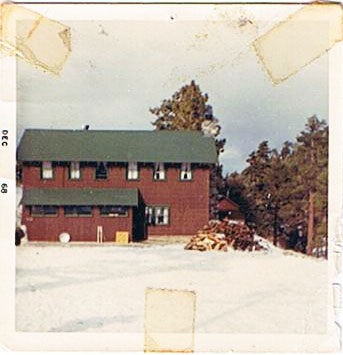 Big Pines Ski Club Lodge, circa 1968. I took this photo with my old
Instamatic camera with 126 film when I was eight years old! (Photo: K. Anderberg, 1968)
Big Pines Ski Club Lodge, circa 1968. I took this photo with my old
Instamatic camera with 126 film when I was eight years old! (Photo: K. Anderberg, 1968)
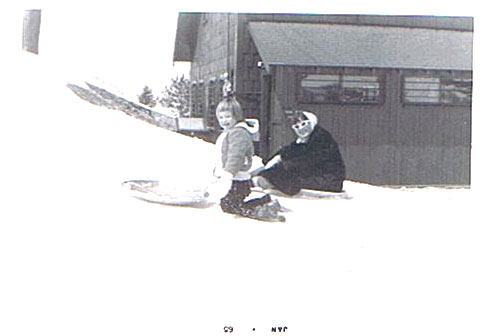 Kirsten Anderberg (age 4), with her mom, outside the Big Pines Ski Lodge, circa 1965 (Photo: Archives of K. Anderberg)
Kirsten Anderberg (age 4), with her mom, outside the Big Pines Ski Lodge, circa 1965 (Photo: Archives of K. Anderberg)
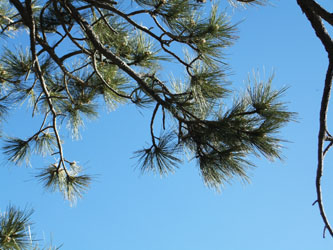 Big Pines was named after the big Jeffrey and Ponderosa Pine trees in the region. This pine tree, photographed in 2009, is on Table Mountain, above the old ski lodge
site. (Photo: K. Anderberg)
Big Pines was named after the big Jeffrey and Ponderosa Pine trees in the region. This pine tree, photographed in 2009, is on Table Mountain, above the old ski lodge
site. (Photo: K. Anderberg)
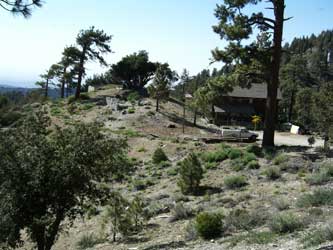 The old Big Pines Ski Lodge now, in 2009, from the road above. (Photo: K. Anderberg)
The old Big Pines Ski Lodge now, in 2009, from the road above. (Photo: K. Anderberg)
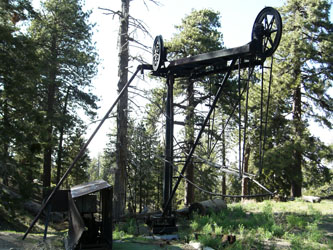
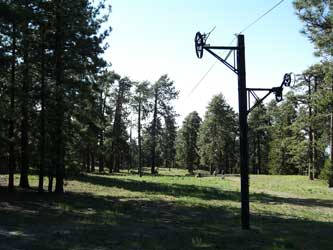 The old rope tows (referenced in the paragraph above) on Table Mountain still stand, swinging in the wind, as they disintegrate in the elements.
This photo was taken in 2009. My father took me on this rope tow just a few times, when I was just learning how to ski, before taking me to the ski slopes on Holiday Hill and Blue Ridge, as I got older. (Photo: K. Anderberg)
The old rope tows (referenced in the paragraph above) on Table Mountain still stand, swinging in the wind, as they disintegrate in the elements.
This photo was taken in 2009. My father took me on this rope tow just a few times, when I was just learning how to ski, before taking me to the ski slopes on Holiday Hill and Blue Ridge, as I got older. (Photo: K. Anderberg)
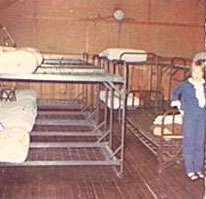 Kirsten Anderberg, age 8, in the Big Pines Ski Lodge upstairs dormitory, circa 1968 (Photo: Archives of K. Anderberg)
Kirsten Anderberg, age 8, in the Big Pines Ski Lodge upstairs dormitory, circa 1968 (Photo: Archives of K. Anderberg)
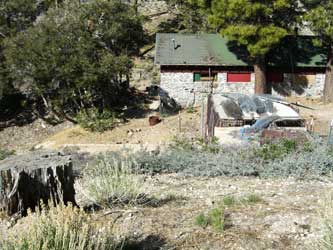 This is a photo of the back of the old ski lodge now, in 2009. The building is the old annex, missing windows, and in
front of the annex are the historic old bear cages from the animal park, now covered by junk owned by the current private resident. (Photo: K. Anderberg)
This is a photo of the back of the old ski lodge now, in 2009. The building is the old annex, missing windows, and in
front of the annex are the historic old bear cages from the animal park, now covered by junk owned by the current private resident. (Photo: K. Anderberg)
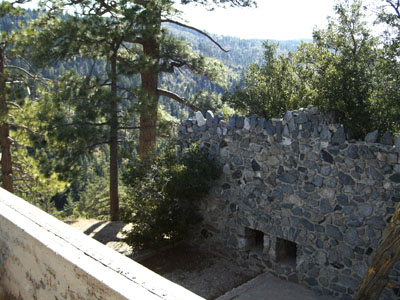 A photo of the abandoned zoo behind the ski lodge in 2009 (Photo: K. Anderberg)
A photo of the abandoned zoo behind the ski lodge in 2009 (Photo: K. Anderberg)
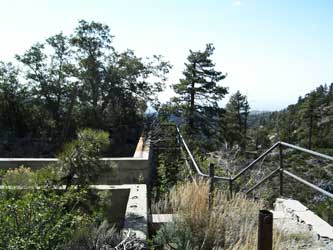 A photo of the abandoned zoo's railings, left behind in the woods, in 2009 (Photo: K. Anderberg)
A photo of the abandoned zoo's railings, left behind in the woods, in 2009 (Photo: K. Anderberg)
 A photo of the abandoned zoo (on left) with Mountain High ski slopes in background, in 2009 (Photo: K. Anderberg)
A photo of the abandoned zoo (on left) with Mountain High ski slopes in background, in 2009 (Photo: K. Anderberg)
 Inside the abandoned zoo behind the ski lodge, in 2009 (Photo: K. Anderberg)
Inside the abandoned zoo behind the ski lodge, in 2009 (Photo: K. Anderberg)
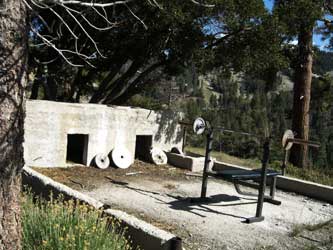 The abandoned zoo in 2009. (Photo: K. Anderberg)
The abandoned zoo in 2009. (Photo: K. Anderberg)
 This used to be a little house with a wooden roof, next to the ski lodge. I used to play near it all the time. It is now just a pile of rocks, in 2009. (Photo: K. Anderberg)
This used to be a little house with a wooden roof, next to the ski lodge. I used to play near it all the time. It is now just a pile of rocks, in 2009. (Photo: K. Anderberg)
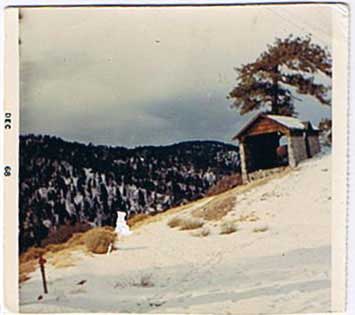 I found a picture of the little house! Here it is! I remember that big rusty tank inside there. I used to sit next to this house and watch all the lizards and play with the acorns. There
must be an oak tree there as I remember the ground being covered with acorns. (Photo: K. Anderberg, 1968)
I found a picture of the little house! Here it is! I remember that big rusty tank inside there. I used to sit next to this house and watch all the lizards and play with the acorns. There
must be an oak tree there as I remember the ground being covered with acorns. (Photo: K. Anderberg, 1968)
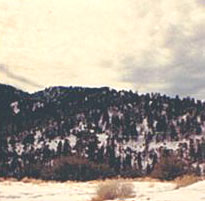 This was the view to your right when leaving the Big Pines Ski Lodge in 1966 (Photo: K. Anderberg)
This was the view to your right when leaving the Big Pines Ski Lodge in 1966 (Photo: K. Anderberg)
 The hill next to the ski lodge, full of oak acorns and lizards (in 2009), much as it was in 1960...(Photo: K. Anderberg)
The hill next to the ski lodge, full of oak acorns and lizards (in 2009), much as it was in 1960...(Photo: K. Anderberg)
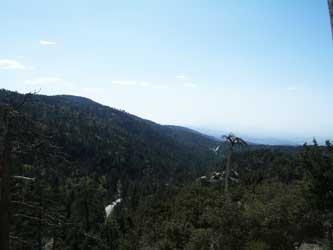 This is the view from the property the ski lodge is on, in 2009, overlooking the Angeles National Forest below...(Photo: K. Anderberg)
This is the view from the property the ski lodge is on, in 2009, overlooking the Angeles National Forest below...(Photo: K. Anderberg)
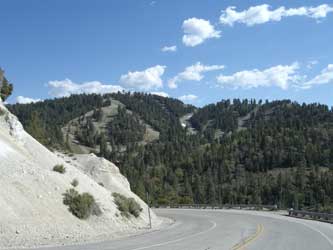 This is the road in front of the ski lodge. You can see the break in the metal road railing on the right side of the picture, where the driveway still is gated. That driveway
was one of two driveways to the ski lodge in the 60's and 70's. It was the least used due to it bordering the cliff. The most used driveway to the ski lodge was closer to the forefront
of this photo, and the break in the railing is still there where the old driveway was, but it is now blocked with a large pile of white rocks from across the road. The white
rocks coming off of the hill to the left in the photo is called "fault flour" as that white rock is literally created by the grinding of rocks on the San Andreas Fault underneath.
Mountain High ski resort is in the background. (Photo: K. Anderberg)
This is the road in front of the ski lodge. You can see the break in the metal road railing on the right side of the picture, where the driveway still is gated. That driveway
was one of two driveways to the ski lodge in the 60's and 70's. It was the least used due to it bordering the cliff. The most used driveway to the ski lodge was closer to the forefront
of this photo, and the break in the railing is still there where the old driveway was, but it is now blocked with a large pile of white rocks from across the road. The white
rocks coming off of the hill to the left in the photo is called "fault flour" as that white rock is literally created by the grinding of rocks on the San Andreas Fault underneath.
Mountain High ski resort is in the background. (Photo: K. Anderberg)
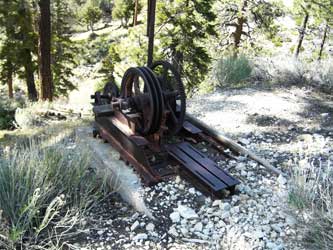 This metal thing is at the top of the road above the old ski lodge. I remember playing with it as a kid. I assume it is some sort of pulley to haul things
up and down from the ski lodge. I assume it was used to *build* the ski lodge, but I really have no idea what it is. Yet more history sitting in the woods, deteriorating
with its own history in the summer sun.(Photo: K. Anderberg)
This metal thing is at the top of the road above the old ski lodge. I remember playing with it as a kid. I assume it is some sort of pulley to haul things
up and down from the ski lodge. I assume it was used to *build* the ski lodge, but I really have no idea what it is. Yet more history sitting in the woods, deteriorating
with its own history in the summer sun.(Photo: K. Anderberg)
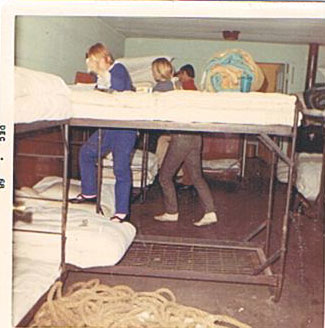 Big Pines Ski Club annex building, 1968 - bathroom through door in back of room...(Photo: Archives of K. Anderberg)
Big Pines Ski Club annex building, 1968 - bathroom through door in back of room...(Photo: Archives of K. Anderberg)
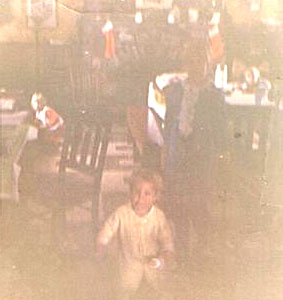 Inside Big Pines Ski Club, in main room downstairs. Note large fireplace in background and large center tables where people would eat and children would play games...(Photo: K. Anderberg, 1968)
Inside Big Pines Ski Club, in main room downstairs. Note large fireplace in background and large center tables where people would eat and children would play games...(Photo: K. Anderberg, 1968)
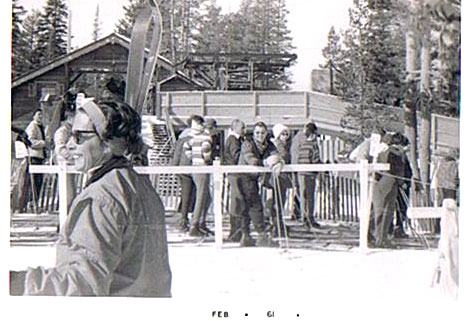 Holiday Hill or Blue Ridge, in February 1961. My dad is the man in the sweater with sunglasses on skis in the center of the picture. (Photo: Archives of K. Anderberg)
Holiday Hill or Blue Ridge, in February 1961. My dad is the man in the sweater with sunglasses on skis in the center of the picture. (Photo: Archives of K. Anderberg)
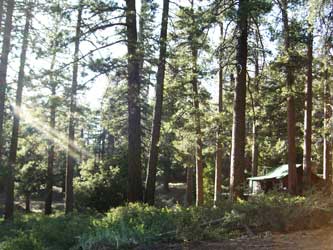 A bit up the road from the ski lodge is McClellan Flat, a site of cottages run and owned by the U.S. Forest Dept., in 2009 (Photo: K. Anderberg)
A bit up the road from the ski lodge is McClellan Flat, a site of cottages run and owned by the U.S. Forest Dept., in 2009 (Photo: K. Anderberg)
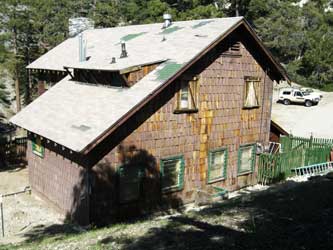 The side of the old Big Pines Ski Lodge, on U.S. Forest land, in 2009. (Photo: K.Anderberg)
The side of the old Big Pines Ski Lodge, on U.S. Forest land, in 2009. (Photo: K.Anderberg)
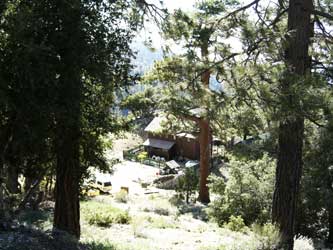 The old ski lodge from above, 2009 (Photo: K. Anderberg)
The old ski lodge from above, 2009 (Photo: K. Anderberg)

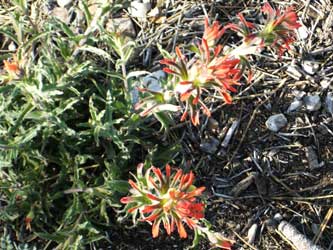
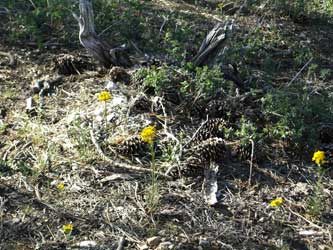 These flowers grow on Table Mountain, where the old ski lodge is.
These photos were taken in May 2009. (Photo: K. Anderberg)
These flowers grow on Table Mountain, where the old ski lodge is.
These photos were taken in May 2009. (Photo: K. Anderberg)
Big Pines, CA, as a city, has little to it sans ski slopes, hiking trails, and camp sites. The nearest town with stores and hotels is Wrightwood. When you enter the Angeles Forest
at Big Pines, you need to buy a pass at the Rangers station which is now housed in the historic old Big Pines Lodge.
Wrightwood, as I have said, is the closest "town" to Big Pines. It is a small village, basically, nestled in the Angeles National Forest foothills. It has little but a few motels,
bars, restaurants, stores, a gas station or two, and a few cabins for rent.
To get to the old Big Pines Ski Club Lodge, you need to head east from anywhere in Los Angeles. If you head out from the San Fernando or Santa Clarita Valleys, it is easiest
to take the Antelope Valley Freeway (or Highway 14), heading northeast towards Palmdale. Just after Acton, and before Palmdale, take Pearblossom Highway (Highway 138) east,
towards Victorville. Pearblossom Highway is in the Mojave Desert, and it is a spectacular drive, especially at sunrise or sunset. The Joshua Trees are beautiful against the setting orange
sun. Stay on Highway 138 as it turns into Antelope Highway, and follow it towards Phelan. Just after Phelan, take a right on Highway 2 and it will take you into Wrightwood. Wrightwood is
a charming little town heavily reliant on the winter ski season for survival. And this is the closest store to Big Pines, so if you want food, etc., this is the place to
get it. Take Highway 2 past Wrightwood, and turn right on Table Mountain Road. The Big Pines Ski Club Lodge was to the left, just a little bit up the road. You can also get there by
taking Highway 2 from the Burbank/Glendale/Pasadena area. That route is a winding forest road. You can also get there by taking Highway 15 out of the Rancho Cucamonga/Fontana
area, north to Highway 138, to Highway 2...into Wrightwood, then Big Pines.
Odd Local History:
Some Wrightwood/Big Pines Resources:
 A ski lift at Mountain High, at what was formerly Holiday Hill, just below the Big Pines Ski Lodge, during the summer, 2009. (Photo: K.Anderberg)
A ski lift at Mountain High, at what was formerly Holiday Hill, just below the Big Pines Ski Lodge, during the summer, 2009. (Photo: K.Anderberg)
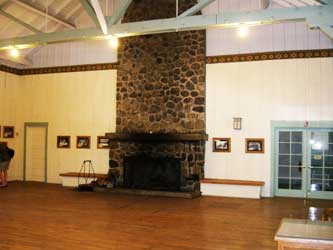 The old Big Pines Lodge, in 2009. This lodge was a community center in its heyday, hosting parties throughout the year. The hall remains empty now, displaying
historic photos of its yesteryears, and the buildings attached to it now house the ranger station. (Photo: K.Anderberg)
The old Big Pines Lodge, in 2009. This lodge was a community center in its heyday, hosting parties throughout the year. The hall remains empty now, displaying
historic photos of its yesteryears, and the buildings attached to it now house the ranger station. (Photo: K.Anderberg)
 This is one of two towers which used to be on either side of the road, with a stone arch across the top over the road into Big Pines. The arch was taken down to
accomodate the road traffic from Highway 2 coming through town in 1950. The other tower was also removed but the north tower remains in 2009. "The Divide, which is the location
of the Big Pines Visitor Center, is the highest point (6,862 feet) along the entire length of the
(San Andreas) fault. The large rock tower, just to the west of the Visitor Center, marks the exact location of the San Andreas’ highest elevation." - Big Pines Visitors Center (Photo: K. Anderberg)
This is one of two towers which used to be on either side of the road, with a stone arch across the top over the road into Big Pines. The arch was taken down to
accomodate the road traffic from Highway 2 coming through town in 1950. The other tower was also removed but the north tower remains in 2009. "The Divide, which is the location
of the Big Pines Visitor Center, is the highest point (6,862 feet) along the entire length of the
(San Andreas) fault. The large rock tower, just to the west of the Visitor Center, marks the exact location of the San Andreas’ highest elevation." - Big Pines Visitors Center (Photo: K. Anderberg)
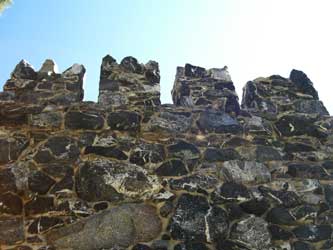 The rockwork on the old Big Pines Lodge north tower is pure art, and remains standing in 2009. (Photo: K.Anderberg)
The rockwork on the old Big Pines Lodge north tower is pure art, and remains standing in 2009. (Photo: K.Anderberg)
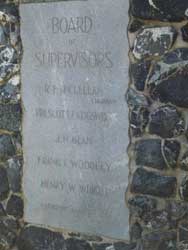 The plaque on the old Big Pines Lodge north tower shows names of powerful men at one time, such as Henry Wright, of Wrightwood, and R.F.McClellan, of
McClellan Flat, and I would not be surprised if Frank Woodley is the same person Woodley Ave in Granada Hills and the San Fernando Valley is named after. (Photo: K.Anderberg)
The plaque on the old Big Pines Lodge north tower shows names of powerful men at one time, such as Henry Wright, of Wrightwood, and R.F.McClellan, of
McClellan Flat, and I would not be surprised if Frank Woodley is the same person Woodley Ave in Granada Hills and the San Fernando Valley is named after. (Photo: K.Anderberg)
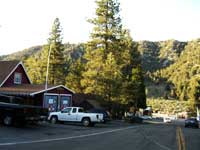
 Wrightwood, CA in 2009. (Photo: K.Anderberg)
Wrightwood, CA in 2009. (Photo: K.Anderberg)
Crashed fighter plane outside Wrightwood
Wrightwood History
Geology of the Area
Geology Photos of Swarthout Valley
History of Big Pines Ski Area
"Wrightwood and Big Pines" Book
The Big Pines Ski Jump
http://www.wrightwoodcity.com/index.html
Wrightwood Live Pictures
Mountain High Ski Resort Webcam
Table Mountain History
An Essay on Wrightwood
Wrightwood, CA Forum
Wrightwood Lodging
San Andreas Fault in Wrightwood
Past Quake Evidence in Wrightwood
Thank you to Resist.ca for hosting this website!









